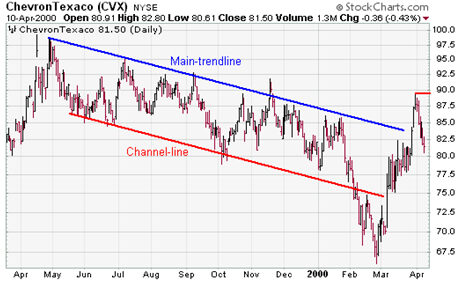What is a Price Channel?
In technical analysis, a price channel is an upper limit (called the resistance) and a lower limit (called the support) in which a security's price tends to stay.
How Does a Price Channel Work?
Price channels can slope up (indicating bullish sentiment) or down (indicating bearish sentiment); they don't have to simply go 'sideways.' The important geometric characteristic is that the resistance and support lines are parallel, as shown in this price channel for ChevronTexaco (NYSE: CVX):

The channel lines themselves are often based on multiday moving averages or logarithmic scales that reflect price movements in percentage terms. However, technical trading is as much an art as it is a science, so one technical trader's price channel might be different from another's.
When a stock's price touches either the resistance or the support, this may signal a trend change, which is why price channels are very important to technical traders.
[InvestingAnswers Feature: Swing Trading Support & Resistance Secrets]
Why Does a Price Channel Matter?
Price channels help tip traders off about trend changes in a stock or 'unusual' activity when the price goes above or below the price channel lines (we call this a breakout). A technical trader might buy when a stock hits the lower limit of an upward-sloping price channel; similarly, traders might sell when a stock hits the upper limit of a downward-sloping channel.
[InvestingAnswers Features: Swing Trading's 11 Commandments: Top Strategies for Technical Analysis]



